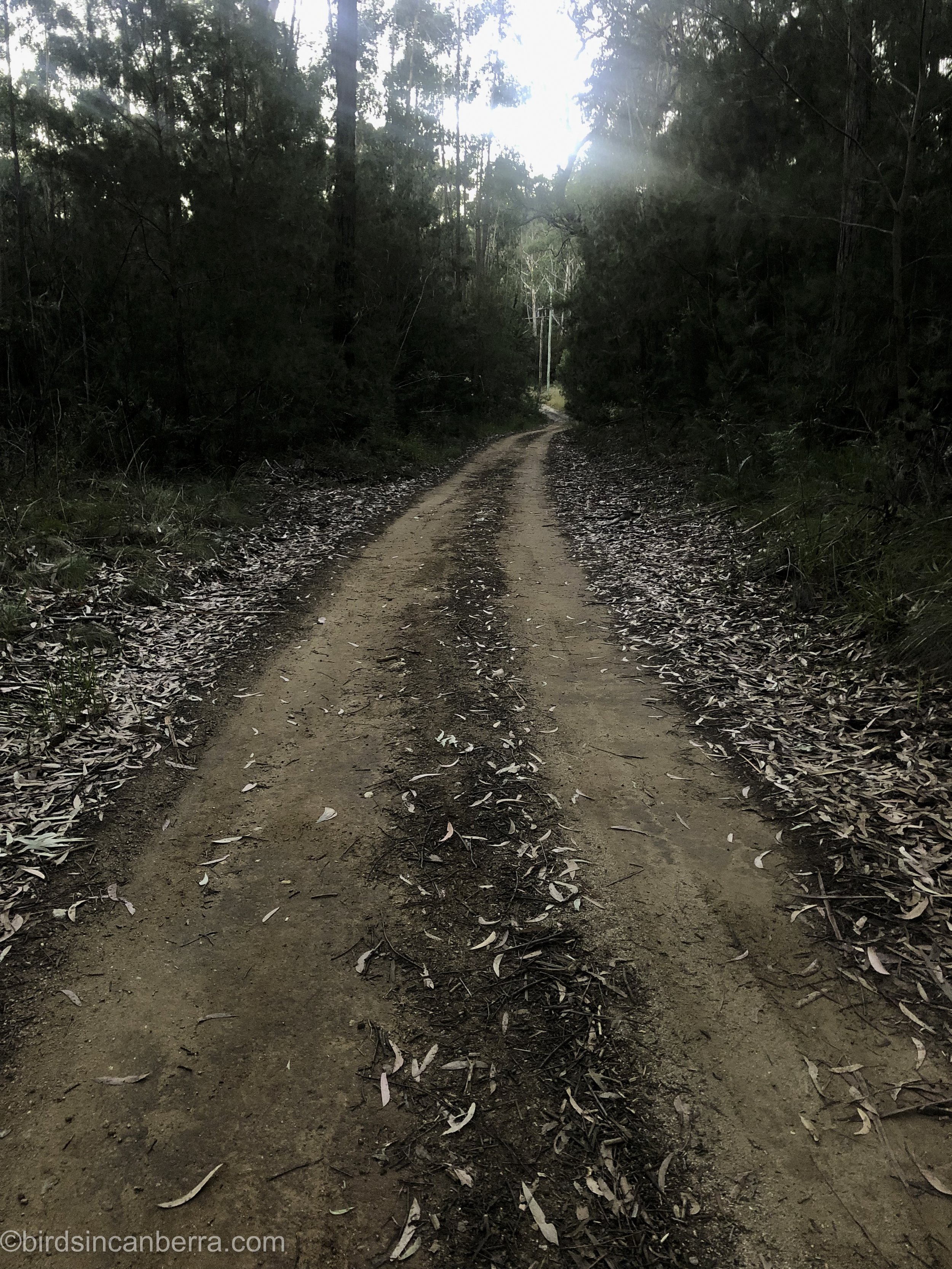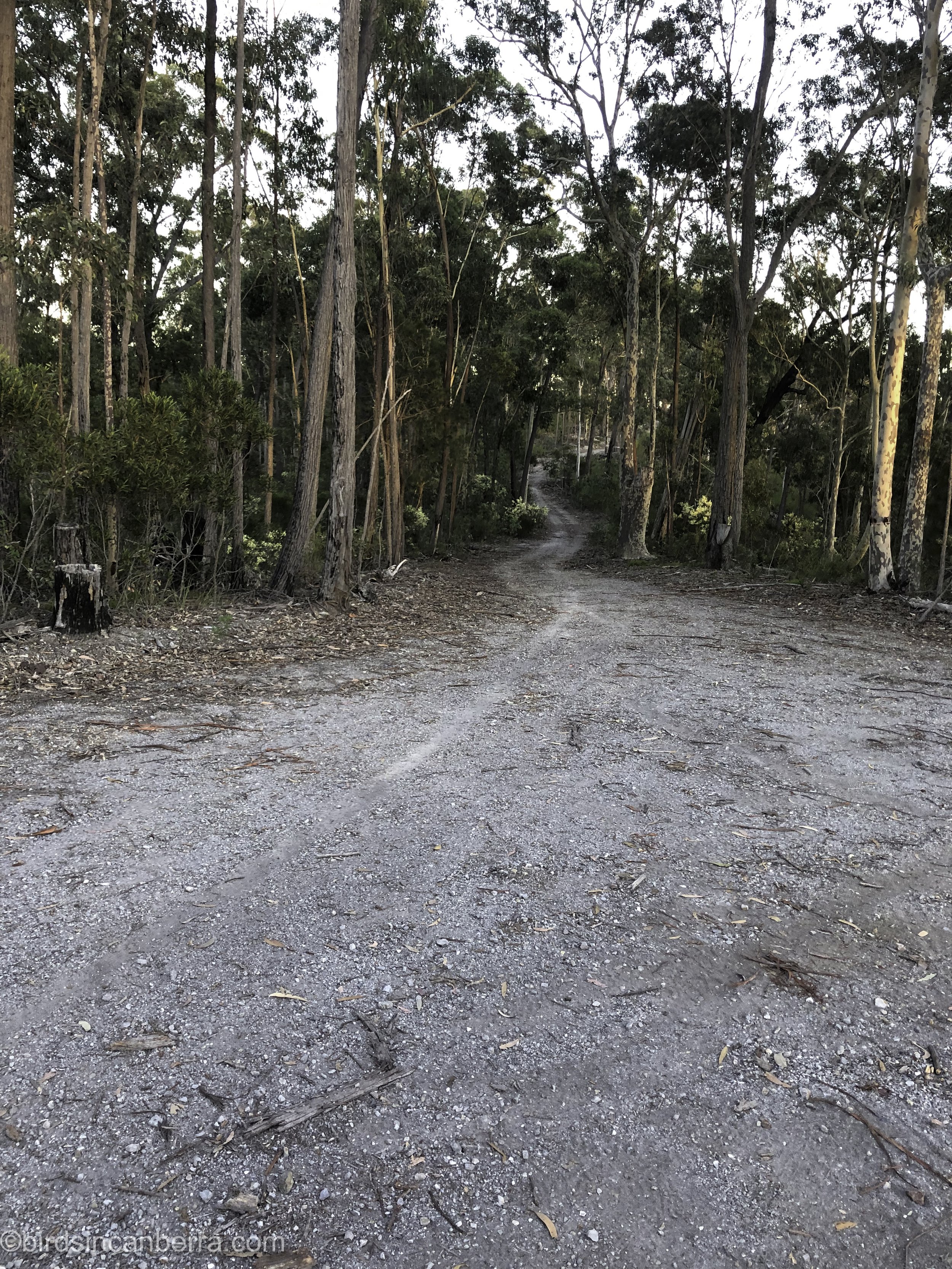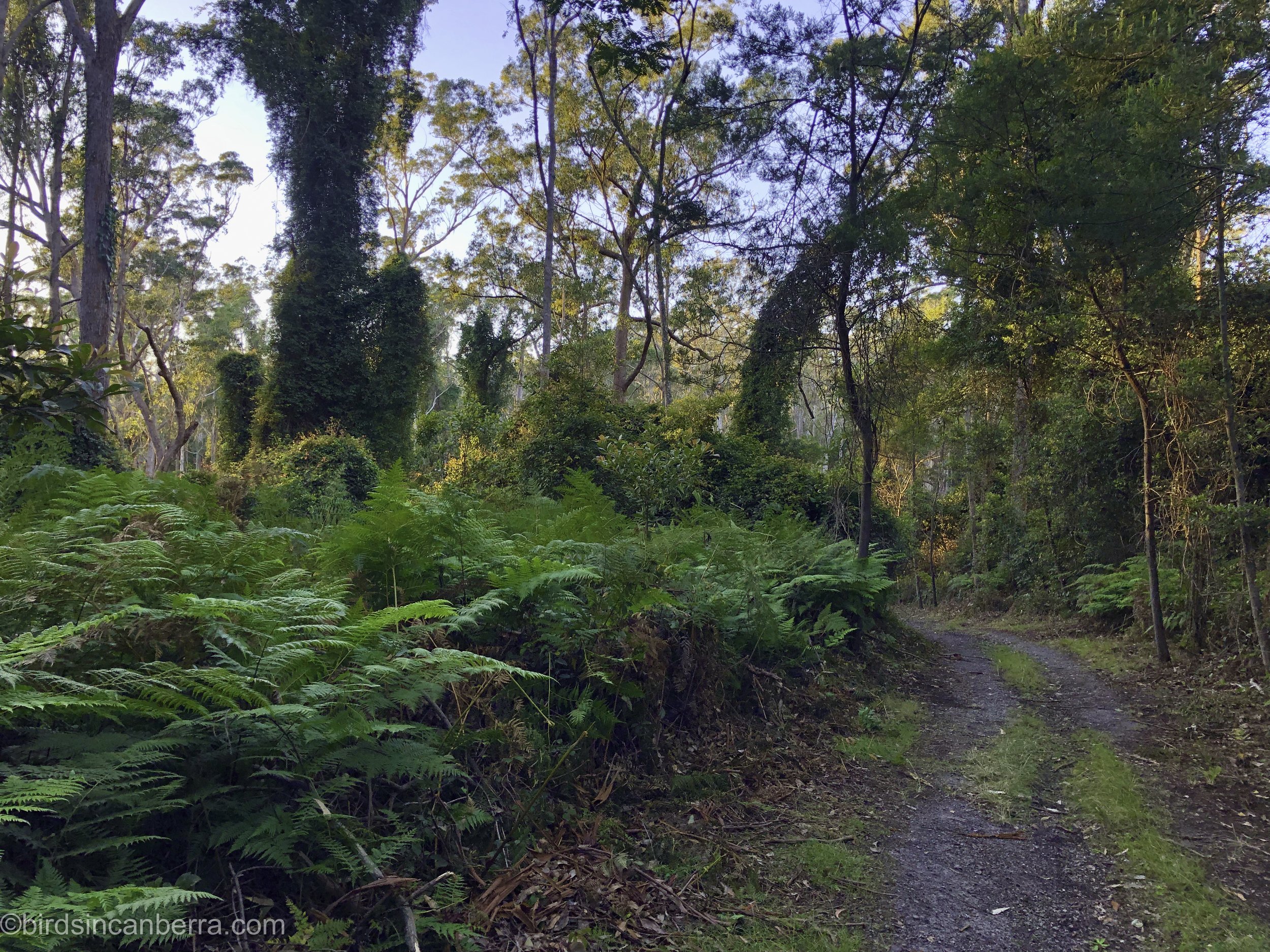That Sunday morning I just wanted to do some photography. Finding the time to photograph and then having good light had been challenging for a few months but I was going out regardless that morning. The previous day, while bike riding, I had seen how the low tide towards the entrance of Wagonga Inlet exposed sandflats around two small islands, which were located behind the rocks being used to train the river. There were a number of shorebirds searching for food in that area so I wanted to return to photograph them. Unfortunately, Sunday’s wind was brisk making it hard to get crisp photos because the breeze was rippling the finer details of the the birds feathers. Despite that, I was happy to see some Pied Oystercatchers. One of the birds was not too bothered by my presence. It remained a short distance away while I walked carefully to try to get the best light on it. The bird appeared to be not interested in feeding, remaining still, with one leg tucked into its feathers. I was the only person on the sandflats, so it was just me and the birds. It was so wonderful to be back photographing and letting the time tick by while I was lost in the birdlife. I really enjoyed the weekend, but especially that morning, and I hope that you enjoy the photographs below.
On the Saturday I went for a bike ride along some of the dirt fire trails behind North Narooma. I was interested in exploring the area with the idea that I would follow the trails northwards before crossing the Princes Highway to ride to Dalmeny and the start of the Dalmeny to Narooma shared path. I was so glad that I followed the route because the dirt trails led me through a number of different environments. I was surprised to see the different habitats so close together. I was also often distracted by birds fleeting through the trees beside the trail. While riding along different parts of the route I saw three lyre birds dash across in front of me. At one place along a ridge, where there was low scrub bordering the trail, I stopped to make sure I was indeed heading in the right direction. While I was stopped a Eastern Yellow Robin with its lovely yellow breast plumage flew quickly onto the ground just in front of me, glanced at me, jumped around, grabbed something before flying off to a small shrub, momentarily pausing, and then off into the thicker growth around me. It was a lovely interaction, and I enjoyed being in the moment.
After the dirt trails I cycled along an almost empty Mort Avenue towards Dalmeny. The road passed by a quiet corner of Lake Mummuga where a single Black Swan was preening itself. The light breeze was making ripples on the lake and small boats were gently rocking at their moorings. The scene was very peaceful as Dalmeny was not yet ready to fully wake up.
A Black Swan in a quiet corner of Lake Mummuga
(Canon EOS 6D Mk II with a Canon EF70-200mm f/4L IS II USM [ISO 500, 187mm, f/14 and 1/250 SEC])
I continued the ride out along the central breakwater at the entrance to Wagonga Inlet and enjoyed the view to the mouth of the inlet. On that morning, two Black Swans (Cygnus atratus) were swimming in the shallow waters behind the rocky channel walls. They were the only obvious birds and the sun made their damp red beaks glisten. Occasionally, they would submerge their heads to eat the weeds on the bottom.
Two Black Swans on Wagonga Inlet
(Canon EOS 6D Mk II with a Canon EF70-200mm f/4L IS II USM [ISO 400, 200mm, f/11 and 1/400 SEC])
Later in the morning, I was cycling back from town and ducked along the path under the Narooma Bridge. Movement in the shallow water of a separating brown blob caught my attention when two Maori Octopuses (Macroctopus maorum) broke apart. I am not sure what was going on but one of them moved well away from the other. The water was very shallow, it was probably less than half a metre deep and just near the raised walkway I was on. The one that moved away looked to almost hide behind some convenient Bubble Weed, while the other stayed in the location they had both shared when I first noticed them. A seal swam in an easterly direction towards the sea in the slightly deeper water just beyond them and I was worried that one of these eight-armed molluscs was going to end up as a meal but they remained undetected. Eventually, the one occupying the original location ducked into a clump of weeds and disappeared. The other octopus did a quick colour shift, which I only noticed while processing the photos, before it also swam off into a hiding spot. I was amazed to see these two octopuses, which were both at least 50cm across so close to the shore, in such shallow water. I was really happy to catch the colour shift and I looked at the photograph metadata to see that the photos were only two seconds apart. I suspect if I had been cycling past without seeing movement I would not have noticed the octopus curled up in the water only a couple of metres from the walkway. Despite its name this octopus is a native in Australia, where it would usually be found in deeper water. Its preferred food are specific crab and lobster species but it will also eat fish when other food is sparse.
Maori Octopus moving through some very shallow water
(Canon EOS 6D Mk II with a Canon EF70-200mm f/4L IS II USM [ISO 400, 200mm, f/8.0 and 1/250 SEC])
The same octopus taken two seconds later, showing a slight colour change
(Canon EOS 6D Mk II with a Canon EF70-200mm f/4L IS II USM [ISO 400, 200mm, f/8.0 and 1/250 SEC])
Later on that Saturday, when I was back at home, I noticed a small creature in one of the rooms beside a skirting board. Upon taking a closer look I realised it was a scorpion, what I believed was a Wood Scorpion (cercophonius squama). I took a few photographs with my macro rig but I did not see any movement, so I thought that it must be dead. I was a bit disappointed so I gave the scorpion a slight prod with my finger, only to see the tail raise and the claws move up. I quickly moved my finger back. I am not sure where the scorpion had been in the house but it looked like it had found every bit of detritus along the skirting board, including dead creatures. It was only just over 3cm long with a nice dark and light brown mixed armoured body. Its claws where not thick but opened menacingly like a crab retreating under a rock. After taking some photographs I scooped it into a container to remove it from the house. The scorpion was not very accommodating, trying to run away. In running, it dropped its tail to a sideward curl with its claws low and its legs moving it forward in a flat run. Once I was able to get it in the container, it resumed its scorpion pose with its tail curled up. Apparently the sting will cause localised, intense pain but nothing more, although I did not want to confirm that information empirically.
Wood Scorpion, which has crawled through a web, on our tile floor
(Canon EOS 6D Mk II with a Canon EF100mm f/2.8L Macro IS USM [ISO 100, 100mm, f/14 and 1/180 SEC] with Canon 430EX III-RT flash)
Sunday arrived with blue skies and I just wanted to go photographing. Having enjoyed looking at the swans the day before in the waters behind the rocky inlet walls I decided to head to that part of the inlet because the sun would be at my back when I was looking towards any birds. It was only a very short drive from the place that I was staying in and I could park right where there was a gap in the coastal scrub to allow access to the sand. After parking the car, I emerged slowly through the low scrub onto the sandflat I could see a number of shorebirds slowly moving through the shallow waters of the receding tide. I was excited to be there with all those birds and with a warming sun on my back.
Away from me, towards the rock wall, a long-legged White-faced Heron (Egretta novaehollandiae) was stalking through a deeper part of the puddling water. It was gazing intently, occasionally spearing its beak at something below it.
White-faced Heron
(Canon EOS 6D Mk II with a Canon EF100-400mm f4.5-5.6L IS II USM [ISO 400, 400mm, f/8.0 and 1/400 SEC])
That sandy area was definitely a great place to see Pied Oystercatchers (Haematopus longirostris). There were a few pairs walking through the water, drilling their beaks into the sediment for little creatures.
Pied Oystercatcher
(Canon EOS 6D Mk II with a Canon EF100-400mm f4.5-5.6L IS II USM [ISO 400, 400mm, f/8.0 and 1/500 SEC])
A group of Little Pied Cormorants (Microcarbo melanoleucos) were taking advantage of the warm sun hitting the rocks to preen their feathers. Despite several boats going past them they were not disturbed. The presence of this group probably shows the health of the inlet in that these birds are comfortable with the amount of prey present to support all of them.
Little Pied Cormorants preening themselves on rocks
(Canon EOS 6D Mk II with a Canon EF100-400mm f4.5-5.6L IS II USM [ISO 640, 400mm, f/14 and 1/320 SEC])
A group of Australian White Ibis (Threskiornis molucca) were also moving through the shallow waters. These birds had the longest legs of the several species gathered in this area. The bird in the photo is probably a juvenile given the less than white feathers, a shorter bill than an adult and the feathers on the neck and head. These birds eat a variety of creatures both on the land and in the water.
Australian White Ibis
(Canon EOS 6D Mk II with a Canon EF100-400mm f4.5-5.6L IS II USM [ISO 320, 400mm, f/8.0 and 1/400 SEC])
A small flock of Grey Teal (Anas gracilis) were swimming in the water, dabbling their heads just under the surface to filter food in to their mouths while they were swimming. They stayed reasonably close to each other, swimming along in the middle of the water. Teals are the smallest of the ducks and will happily live in both fresh and saltwater.
They had probably spent some time on the damp sand bordering the area because their imprints were still visible when I walked past. The pointed claws and webbed-feet clearly showing in the sand where they had been.
Grey Teals
(Canon EOS 6D Mk II with a Canon EF100-400mm f4.5-5.6L IS II USM [ISO 400, 400mm, f/8.0 and 1/500 SEC])
Imprints of ducks in the sand
(Canon EOS 6D Mk II with a Canon EF100-400mm f4.5-5.6L IS II USM [ISO 400, 100mm, f/8.0 and 1/500 SEC])
Narooma continues to fascinate me with so much wildlife to see. The weather has been coolish but sunny making it very inviting to get out exploring, especially with a camera. I loved that little sandflat and the chance to see so many birds feeding. I am sure that once winter is over there will be even more birds. Narooma truly is a wonderful treasure on the south coast of New South Wales.
Thanks for reading this post and thanks also for looking at my photos. I hope you come back again to read more about some of the wonderful natural things that the south coast of New South Wales has on offer. All the best until the next post.


